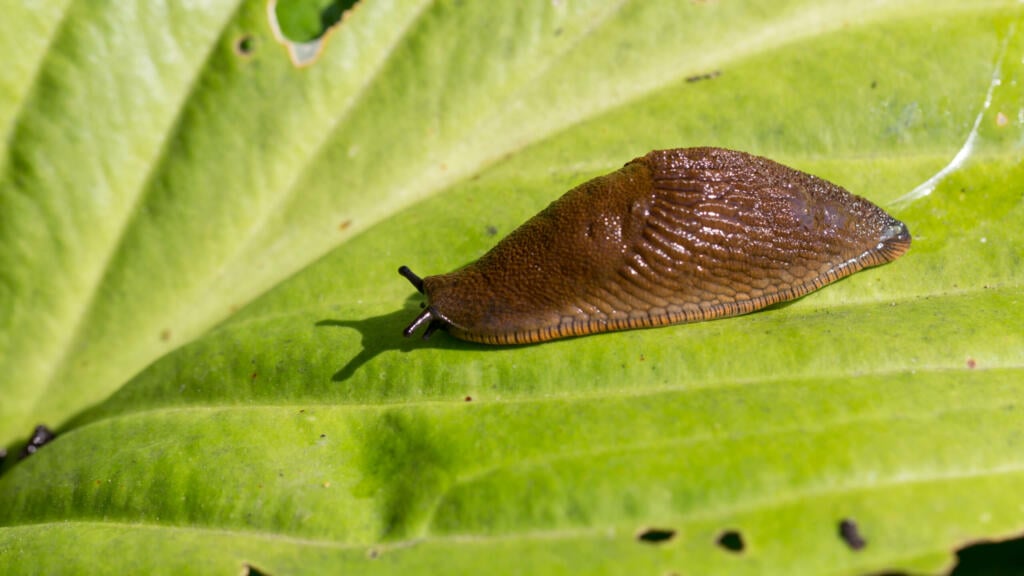
How to get rid of weeds without using chemicals
Camilla Sharman
We’ve got 11 ways to prevent your plants being eaten by slugs.
 Credit: Shutterstock/Marija Stepanovic
Credit: Shutterstock/Marija StepanovicHow do you react when you hear the word slug? Do your shoulders hunch up while you let out an “eurgh” sound? What is it about these shell-less creatures that causes such a negative reaction in gardeners and non-gardeners alike?
Slugs are uninvited guests, rudely munching through your prized plants and crops. They have thousands of tiny teeth on their tongues that make holes in leaves, stems, buds, flowers, roots and tubers, and leave a silvery trail of destruction in their wake.
Although they have a part to play in the ecosystem – they do a great job in speeding up the decomposition process in compost heaps and are a nutritious food source for birds and insects – most gardeners prefer to see them banished. But how easy is it to keep slugs out of the garden?
It’s worth getting inside a slug’s mind to discover its culinary likes and dislikes, and grasp its behaviours. Once you understand that, you can adapt your gardening techniques to protect your plants and the valuable ecosystem that slugs play a part in.
 Credit: Shutterstock: Tomasz Klejdysz
Credit: Shutterstock: Tomasz KlejdyszThere are some plants that slugs adore and others they detest. So to keep them away from your prized specimens, it’s good practice to plant them alongside the plants they hate. This method of companion planting will keep slugs away from the whole area.
But what do slugs like to make a meal of? They enjoy their veg and ornamental plants, and are particularly partial to “seedlings and soft young shoots on herbaceous plants”, according to the RHS.
To protect young seedlings, Dr Hayley Jones, senior entomologist at the RHS Plant Health team, says: “There are cultural changes you can make in your garden to try to head off problems with slugs, such as growing seedlings until they are bigger and sturdier before planting out.”
Slugs also enjoy bedding plants, and will happily munch through petunias and pansies.
Although slugs have plenty of teeth, they don’t like hard stems and tough, hairy or waxy leaves, which they find harder to chew. They also turn their noses up at heavily fragranced foliage.
According to Gardeners World, slugs dislike foxgloves and euphorbias as they have toxic leaves, and avoid thick and hairy foliage of Stachys and pulmonaria. In the veg patch, they detest the bitter taste of many Mediterranean herbs, such as basil, rosemary and thyme.
Plenty of deterrent plants will keep slugs away from their favourite treats. Here are a few that will help keep slugs out of your garden.
Don a pair of gardening gloves or grab a small gardening trowel and remove the slugs by hand. The best time to go slug spotting is after dark, so take a torch. Rebecca Bevan, senior national consultant for plant health and sustainability at the National Trust and author of The National Trust School of Gardening, suggests checking under pots on warm, damp evenings.
Disposing of slugs
Once slugs are discovered, the RHS suggests moving them to a compost heap or another part of your garden with less vulnerable plants. They can even be killed in the freezer (but do make sure to label them and keep them away from your edibles), before feeding them to the birds or popping them in a compost bin.
And if you can’t bring yourself to do the deed in person, my top tip is to ask someone else to do it for you!
 Credit: Shutterstock/Nedim Bajramovic
Credit: Shutterstock/Nedim BajramovicThe RHS recommends creating a slug trap with an orange, grapefruit or melon that’s been cut in half and scooped out. It should then be placed, cut side down in the garden, ensuring there is enough room for the slugs to enter. The grapefruit rinds provide a food source for the slugs and a damp hiding place. Place the fruit rinds out overnight and collect any slugs trapped inside in the morning.
Slugs are so attracted to the yeasty smell of beer that they will crawl inside a container of this much-loved tipple, where their fate is sealed by drowning. It’s not an ideal method if you prefer a humane option, but it does get results.
You’ll need to put out several beer traps as they only work within a limited range. Also, the beer will evaporate and will need topping up every day or two – so we don’t recommend using your favourite craft beer for the job.
How to make a beer trap
The slugs will climb over the cup’s rim and into the beer, where they will drown. In the morning, tip out the beer, and dispose of the dead slugs by burying them back into the ground, feeding them to the birds or adding to your compost bin.
 Credit: Shutterstock/Jurga Jot
Credit: Shutterstock/Jurga JotEggshells and nut shells will act as deterrents as slugs don’t like crawling over sharp objects. Both can be broken into pieces and placed around the plants you want to protect. The shells will eventually decompose and enrich the soil.
Fresh and powdered seaweed sprinkled around the base of a plant will act as a slug deterrent, although be careful to avoid putting it on your plants. The salt in the seaweed draws water from the slug’s skin and causes dehydration, so they will tend to avoid it. Once the seaweed dries out, it will become sharp and spiky, causing another barrier for slugs as they won’t be able to cross it.
Sarah Raven sells seaweed slug repellent, £16.95 for 1.2kg.
There is some uncertainty over coffee’s reliability as a slug repellent, but this could be down to the method of application rather than the product itself. While the odour of dried coffee grounds spread around the base of a plant may prevent slugs from venturing further, spraying the plant with a caffeine solution is a more reliable method, according to research conducted by The University of Nebraska in the US. The study found that slugs were killed by spray applications containing 1-2% of caffeine.
However, as caffeine deters pollinators, avoid spraying it on flowering plants.
Wool pellets may look like slug pellets but they are not the same. They’re made up of sheep’s wool that is compressed into a pellet shape. The wool pellets work by absorbing the mucus that slugs produce. However, one major disadvantage of wool pellets is that they don’t work when wet, which is when the slugs most enjoy coming out of hiding.
Grab yourself a bag of Vitax – Slug Gone Wool Pellets from B&Q at £6.71 per 1 litre.
Copper rings can be placed around a plant to form a barrier to keep slugs out. But how do they work? When a slug comes into contact with the copper, its mucus reacts with the metal and causes an electric shock, resulting in the slugs being repelled from the area. The RHS has a set of six slug rings for £34.99, available on its website.
Like unwanted weeds, we don’t want to invite slugs into our gardens, but they do have their part to play in the wider picture. Plenty of creatures that will feast on a tasty slug, so encouraging predators into your outside space will help decrease slugs, while supporting the natural ecosystem. Birds, frogs, toads, worms and ground beetles will happily snack on a slug.
Hedgehogs also enjoy a diet of slugs and can be encouraged into your garden by giving them a safe place to stay. The Wildlife Trusts has guidance on how to build a hedgehog home, or you can buy one direct from Riverside Woodcraft for £69.
If you already have a pond in your garden, consider placing those plants most at risk to slugs near to it. This will give any frogs and newts a plentiful supply of food. Even ducks are known to enjoy a slug or two.
The RSPB advises on its website that slug pellets should only be used as a last resort, and we should only use those containing ferric phosphate (also called iron III phosphate). When eaten, this type of pellet causes slugs to stop feeding and die within three to six days. They should be used sparingly and stored safely. “Although ferric phosphate is less toxic than metaldehyde, the other ingredients in the tablets can also affect earthworms and, if consumed in large quantities, can poison pets,” the RSPB warns.
Before using any old slug pellets that you find in your shed, check to see if they contain metaldehyde. The chemical is banned (see below) and should not be used as a slug repellent.
Banned slug pellets
In March 2022, the Government banned slug pellets containing the pesticide metaldehyde, as it posed significant risks to birds and mammals. While it acknowledged the harm slugs cause to crops and gardeners’ plants, it recommended alternative products containing ferric phosphate that “can provide effective control without carrying the same risks to wildlife”.
Bevan adds: “Metaldehyde was used for decades but it’s now understood to pollute water supplies and to be highly toxic to the creatures that eat poisoned slugs.” It’s for this reason that a ban was introduced to protect wildlife and the environment.
 Credit: Shutterstock/Tony Baggett
Credit: Shutterstock/Tony BaggettThe fact about slugs: Friend of foe?
Slugs are gastropods – single-shelled animals with soft bodies in the mollusc group of animals. According to Dr Hayley Jones, senior entomologist at the RHS plant health team, there are over 40 species in the UK, and many of them don’t eat your prized plants. “Many of them feed on rotting leaves, algae, fungi and other non-plant material,” she explains.
But despite them causing havoc in our gardens, they have their own role to play. “All species, even those harassing your plants, are a part of the garden food web, a source of food for wildlife like birds, frogs and hedgehogs.”
The Soil Association states that four types of slugs cause the most damage: the grey field slug, garden slug, keel slug and black slug. If you’re interested in discovering which species are in your garden, the John Innes Centre has a slug identifier.
As our plants return to life in the spring, we are more aware of the devastating effects of slugs in our gardens because they enjoy fresh, new growth. Although they’re active throughout the year, slugs up their game in warmer weather, and they’re also fond of damp conditions. The Soil Association says slugs increase their activity when the temperatures rise to 5°C (32°F) and above, while dry weather and colder spells mean they’re less active. They are also like the dark and come out at night to eat, while during the day they hide under logs, stones and planters.

Written by Camilla Sharman she/her
Published: Updated:
With her 30 years of experience, Camilla Sharman has covered a wide range of sectors within the business and consumer industries both as a feature, content, and freelance writer. As a business journalist, Camilla has researched articles for many different sectors from the jewellery industry to finance and tech, charities, and the arts. Whatever she’s covered, she enjoys delving deep and learning the ins and out of different topics, then conveying her research within engaging content that informs the reader.